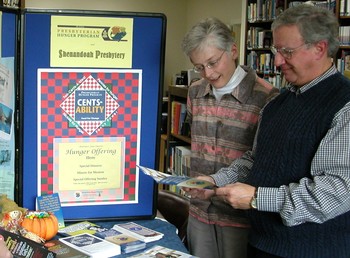Doug Sensabaugh wears a lot of hats in his work with the Shenandoah Presbytery, serving as communications director, mission coordinator and hunger action advocate (HAA). Each week, he devotes time to all three jobs and the immediate needs usually become his top priorities.
“I always make sure to communicate hunger priorities through the presbytery website and other communication channels,” said Sensabaugh, who plans to step down from all of his roles this spring. “I also maintain a hunger page on the site to talk about the issues of the day and have a display at every presbytery meeting on a particular aspect of hunger or poverty.”
Sensabaugh spends a lot of time interacting with colleagues in the community, participating in an organization called the Virginia Interfaith Center of Public Policy, a Presbyterian Hunger Program grant partner. This advocacy group pulls together representatives from all denominations in the region.
“Our biggest concern as a group is for food pantries and whether there is enough food for those who show up each week,” he said. “Even in a community where we live with farms all around, we try to encourage churches to create community gardens. If they have a half acre of land that is not being used, we encourage them to make use of it, set up a vegetable stand where they can [sell produce] or give to a local food pantry.”
Some pantries, according to Sensabaugh, operate from month to month. The presbytery is very active in supporting the churches’ efforts to help. Other denominations such as United Methodists and Baptists also participate. The Presbyterian Hunger Program is often a catalyst in forming ecumenical partnerships in communities working to address the root causes of hunger and poverty.
“The Presbyterian Hunger Program offers Cents-Ability, where congregations are encouraged to keep 25 percent of what they’ve raised through contributions each month and use it for their local hunger ministry no matter what it is,” he said. “Churches are encouraged to send the other 75 percent to the presbytery. Over a year’s time, we’ve collected as much as $75,000. All of it is turned around and sent back into the community for the pantries.”
Sensabaugh says a local landowner gave 40 acres to grow vegetables for area food banks. However, it survived by donations only and had to close during the economic downturn.
“Since we are an agricultural community, we have a lot of farmers that grow vegetables commercially. There is a cooperative here where excess vegetables go up for auction,” he said. “High bidders can then sell the food at vegetable stands or donate to a church. These resources do make a difference to our food pantries.
Across the presbytery, approximately 100 churches support 45 pantries through quarterly donations. Sensabaugh also serves on the local food banks board that supplies about a third of the food in the state.
Sensabaugh also credits the Presbyterian Hunger Program and the interaction with other hunger action advocates.
“When we get together, we exchange a lot of ideas. My interaction with PHP is very helpful,” he said. “It’s important to be a part of the connectional church because PHP has its eyes and ears open to the resources I’m not aware of. PHP makes it available and sponsors a number of events and webinars to help educate and support us.”
Ruth Farrell, coordinator of the Presbyterian Hunger Program says it has been a privilege to partner with Shenandoah Presbytery adding that with Sensabaugh’s leadership, Presbyterian congregations have been a vital witness in their communities meeting needs the way Jesus did, eating with and getting to know by name, those in need.
“Doug’s holistic engagement with congregations in advocating for federal, state and local policies that protect the poor and hungry are a vital part of strengthening our society,” she said. “Children who receive nutritious food through school lunch and summer programs as well as experience care from parents, neighbors and community will carry that forward for years to come.”
Sensabaugh says his only disappointment has been the decrease in the number of hunger action advocates across the denomination as economics have forced presbyteries to reduce their ranks over the years. He’s hoping that trend changes.
As for the future, Sensabaugh plans to step back from the busy pace of daily work and spend more time with his grandson. But he won’t soon forget his experience as a HAA.
“When I came to this work, I didn’t know a thing about the Presbyterian Hunger Program and I grew up in the Presbyterian church,” he said. “I was not aware of its existence, but this has helped me be connected.”
-----
The Presbyterian Hunger Program currently works with Hunger Action Advocates (HAAs) in 30 presbyteries across the U.S. The HAA position is funded through a matching grant to presbyteries from PHP as a part of educating and connecting Presbyterians to the work of PHP. Find the HAA closest to your area or give today to support the efforts of PHP in working together to bring hope to communities and individuals struggling against hunger.

